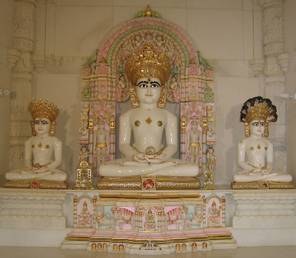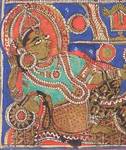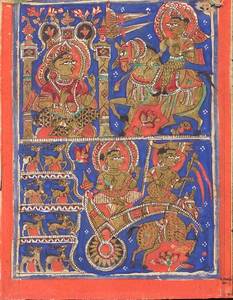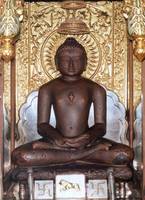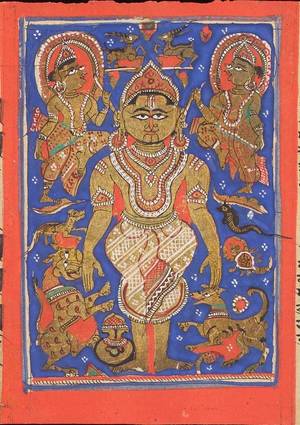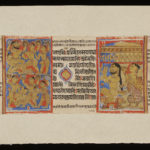Jina
A 'victor' in Sanskrit, a Jina is an enlightened human being who has triumphed over karma and teaches the way to achieve liberation. A synonym for Tīrthaṃkara, which means 'ford-maker' or one who has founded a community after reaching omniscience through asceticism. The most famous 24 – Ṛṣabha to Mahāvīra – were born in the Bharata-kṣetra of the middle world, but more are found in other continents. There have been Jinas in the past and there will be some in the future.
Jina
A 'victor' in Sanskrit, a Jina is an enlightened human being who has triumphed over karma and teaches the way to achieve liberation. A synonym for Tīrthaṃkara, which means 'ford-maker' or one who has founded a community after reaching omniscience through asceticism. The most famous 24 – Ṛṣabha to Mahāvīra – were born in the Bharata-kṣetra of the middle world, but more are found in other continents. There have been Jinas in the past and there will be some in the future.
Sanskrit
A classical language of India, originally used by priests and nobility. Sanskrit has a rich literary and religious tradition. With only a few thousand native speakers nowadays, it is predominantly used in Hindu religious ceremonies and by scholars.
Omniscience
Omniscience, enlightenment or perfect knowledge – the highest of the five types of knowledge, where one knows everything wherever and whenever it is. It is extremely difficult to attain, equivalent to the 13th stage of spiritual purity in the guṇa-sthāna. Digambaras believe only men can achieve it whereas Śvetāmbaras believe that both men and women can become enlightened.
Mokṣa
The 'liberation' of the soul from its body and thus from the cycle of rebirth because it has no karma and becomes omniscient. The ultimate aim of Jainism is to achieve mokṣa and become a liberated soul in siddha-śilā.
Tīrthankara
A ‘victor’ in Sanskrit, a Jina is an enlightened human being who has triumphed over karma and teaches the way to achieve liberation. A synonym for Tīrthaṃkara, which means ‘ford-maker’ or one who has founded a community after reaching omniscience through asceticism. The most famous 24 – Ṛṣabha to Mahāvīra – were born in the Bharata-kṣetra of the middle world, but more are found in other continents. There have been Jinas in the past and there will be some in the future.
Tīrtha
A place that has become sacred owing to its connection with a Jina or another holy figure. It becomes a place of pilgrimage because one of the auspicious events of his life took place there. In another meaning the word refers to the Jain community of monks, nuns, lay men and lay women, or can be used for a mendicant, viewed as a ‘walking tīrtha'.
Jina
A 'victor' in Sanskrit, a Jina is an enlightened human being who has triumphed over karma and teaches the way to achieve liberation. A synonym for Tīrthaṃkara, which means 'ford-maker' or one who has founded a community after reaching omniscience through asceticism. The most famous 24 – Ṛṣabha to Mahāvīra – were born in the Bharata-kṣetra of the middle world, but more are found in other continents. There have been Jinas in the past and there will be some in the future.
Jain
Follower of the 24 Jinas or an adjective describing Jain teachings or practices. The term 'Jaina' is also used although 'Jain' is more common.
Kevala-jñāna
Omniscience, enlightenment or perfect knowledge – the highest of the five types of knowledge, where one knows everything wherever and whenever it is. It is extremely difficult to attain, equivalent to the 13th stage of spiritual purity in the guṇa-sthāna. Digambaras believe only men can achieve it whereas Śvetāmbaras believe that both men and women can become enlightened.
Mokṣa
The 'liberation' of the soul from its body and thus from the cycle of rebirth because it has no karma and becomes omniscient. The ultimate aim of Jainism is to achieve mokṣa and become a liberated soul in siddha-śilā.
Yakṣa
The male attendant of a Jina, one of the pair of guardian or protector gods for each Jina. The śāsana-devatā protect his teachings – śāsana – and can appease evil powers. The yakṣa and yakṣī's closeness to the Jina and their divine powers mean they are popular subjects of worship.
Yakṣī
The female attendant of a Jina, also called yakṣinī. One of the pair of guardian or protector gods for each Jina. The śāsana-devatā protect his teachings – śāsana – and can appease evil powers. The yakṣa and yakṣī's closeness to the Jina and their divine powers mean they are popular subjects of worship.
Deity
A god or divine figure, often with physical powers beyond those of a human and with superhuman abilities.
Mokṣa
The 'liberation' of the soul from its body and thus from the cycle of rebirth because it has no karma and becomes omniscient. The ultimate aim of Jainism is to achieve mokṣa and become a liberated soul in siddha-śilā.
Jain
Follower of the 24 Jinas or an adjective describing Jain teachings or practices. The term 'Jaina' is also used although 'Jain' is more common.
Śvetāmbara
White-clad’ in Sanskrit, the title of one of the two main divisions of Jainism, in which both male and female mendicants wear white robes. There are some differences of doctrine or belief between these two sects and to some extent their followers consider themselves as belonging to distinct branches. Divisions can be fierce in practical matters, for example, over the ownership of pilgrimage places, but all sects see themselves as Jains.
Ṛṣabha
First Jina of the present age. His symbolic colour is gold and his emblem the ox or bull. There is little historical evidence of his existence. Jains believe that he established many social institutions, such as marriage and the caste system, and introduce crafts and agriculture to the people.
Pārśva
The 23rd Jina of the present age. His symbolic colour is green and his emblem the snake. Historical evidence points to his living around 950 to 850 BC.
Idol
An image of a deity or concept that is worshipped either as a god or as a representation of the deity.
Lands of Action
Realm of action', used in Jain cosmology for the lands in the Middle World where people must work to live. However, here they can progress on the path of salvation. These lands are Bharata-kṣetra, Airāvata-kṣetra and Mahā-videha. However, Uttara-kuru and Deva-kuru in Mahā-videha are Lands of Pleasure or bhoga-bhūmi.
Knowledge
Knowledge', of which there are five main types:
- mind-based and sensory knowledge – mati-jñāna
- scriptural knowledge – śruta-jñāna
- extra-sensory knowledge or clairvoyance – avadhi-jñāna
- knowledge of others’ minds or telepathy – manaḥparyaya-jñāna
- omniscience or absolute knowledge – kevala-jñāna.
With spiritual progress, one can gain the different types of knowledge.
Also one of the 14 'gateways' or categories of investigation of
mārgaṇā or 'soul-quest'.
Ṛṣabhanātha
First Jina of the present age. His symbolic colour is gold and his emblem the ox or bull. There is little historical evidence of his existence. Jains believe that he established many social institutions, such as marriage and the caste system, and introduce crafts and agriculture to the people.
Mahāvīra
The 24th Jina of the present age. His symbolic colour is yellow and his emblem the lion. Mahāvīra or 'the great hero' is his title. His birth name was Vardhamāna, meaning 'ever increasing'. His existence is historically documented but the two main sects of Digambara and Śvetāmbara Jains have slight differences in their accounts of his life.
Pārśvanātha
The 23rd Jina of the present age. His symbolic colour is green and his emblem the snake. Historical evidence points to his living around 950 to 850 BC.
Janma
Sanskrit for 'birth' or 'rebirth'.
Dīkṣā
Religious initiation through which a man or woman leaves the householder or lay status to become a mendicant. Parts of this ritual renunciation are public ceremonies, depending on the sect.
Kevala-jñāna
Omniscience, enlightenment or perfect knowledge – the highest of the five types of knowledge, where one knows everything wherever and whenever it is. It is extremely difficult to attain, equivalent to the 13th stage of spiritual purity in the guṇa-sthāna. Digambaras believe only men can achieve it whereas Śvetāmbaras believe that both men and women can become enlightened.
Nirvāṇa
Release from the bondage of neverending rebirths, in which an enlightened human being undergoes his or her final death, followed immediately by salvation instead of rebirth. Note that this differs from the Buddhist concept of the same name.
Auspicious
Favourable or lucky. Auspicious objects bring good fortune and may predict good events or a bright future.
Kalyāṇaka
An auspicious moment in a Jina's life. There are five
pañca-kalyāṇakas:
- garbha – conception
- janma – birth
- vairāgya – renunciation
- kevala-jñāna – enlightenment
- mokṣa or nirvāna – liberation.
Śvetāmbaras
White-clad’ in Sanskrit, the title of one of the two main divisions of Jainism, in which both male and female mendicants wear white robes. There are some differences of doctrine or belief between these two sects and to some extent their followers consider themselves as belonging to distinct branches. Divisions can be fierce in practical matters, for example, over the ownership of pilgrimage places, but all sects see themselves as Jains.
Triṣaṣṭi-śalākā-puruṣa-caritra
Great man' – also known as a
mahā-puruṣa – whose story is told in Jain Universal History. Born in each progressive and regressive half-cycle of time, there are five types of 'great men':
- 24 Jinas
- 12 Cakravartins
- 9 Baladevas
- 9 Vāsudevas
- 9 Prati-vāsudevas.
Triṣaṣṭi-śalākā-puruṣa-caritra
Great man' – also known as a
mahā-puruṣa – whose story is told in Jain Universal History. Born in each progressive and regressive half-cycle of time, there are five types of 'great men':
- 24 Jinas
- 12 Cakravartins
- 9 Baladevas
- 9 Vāsudevas
- 9 Prati-vāsudevas.
Digambara
Sky-clad' in Sanskrit, used for one of the two main divisions of Jainism, in which monks are naked. There are some differences of doctrine or belief between these two sects and to some extent their followers consider themselves as belonging to distinct branches. Divisions can be fierce in practical matters, for example, over the ownership of pilgrimage places, but all sects see themselves as Jains.
Ascetic
Someone who withdraws from ordinary life to meditate and practise physical hardships in order to advance spiritually. Jain ascetics or mendicants beg for food from devout lay followers and wander the land.
Also used as an adjective to describe the practice of rigorous, even extreme, physical hardships in the belief that it leads to a higher spiritual condition.
Ascetic
Someone who withdraws from ordinary life to meditate and practise physical hardships in order to advance spiritually. Jain ascetics or mendicants beg for food from devout lay followers and wander the land.
Also used as an adjective to describe the practice of rigorous, even extreme, physical hardships in the belief that it leads to a higher spiritual condition.
Hindu
Follower of the majority faith in India and an adjective describing something belonging to Hinduism. Hindus have numerous gods and diverse beliefs and practices, though many believe in the soul, karma, the cycle of births and liberation. Roughly a billion Hindus comprise the third largest religion in the world.
Universal History
A Western academic term used for the largely medieval texts that hold the Jain legendary history of the world. Recounting the life stories of the '63 Great or Illustrious Men', the writings are intended to provide role-models for later Jains. The main texts of Jain Universal History are the:
- Śvetāmbara monk Hemacandra's Triṣaṣti-śalākā-puruṣa-caritra – Life Stories of 63 Great Men
- Mahā-purāṇa – Great Ancient Tale – of the Digambara writers Jinasena and Guṇabhadra.
Marudevī
Mother of Ṛṣabha, the first Jina of the present age. A kṣatriya woman, she has the auspicious dreams that indicate the birth of a future Jina while she is pregnant. Śvetāmbaras believe that she was the first person to be liberated in this era but Digambaras hold that the first liberated person was either her son Bāhubali or one of her grandsons.
Kṣatriya
The Indian caste of warriors and kings, with the role of 'protectors'. Jinas are born into this caste.
Caste
Hindu society is traditionally divided into numerous
jātis or classes, which are usually grouped into the four
varṇas – often called 'castes' – of:
- Brāhmaṇa – priest
- Kṣatriya – warrior
- Vaśya – merchant or farmer
- Śūdra – labourer.
Relating to ritual purity, castes are hereditary and probably based on occupation. Members of different castes performed particular socio-economic roles and did not mix or eat the same food. People outside the caste system were usually looked down upon.
Upasarga
Attack or test, especially those posed by disguised gods or bad people to the Jinas before they became omniscient to check whether they could properly meet the demands of asceticism.
Jīva
Sanskrit for 'self', 'soul' or 'that which is sentient'. It makes up the universe along with ajīva, or non-sentient material substance. It is a material substance that changes in size according to the body it inhabits in each life. It is born in different bodies in various places in the Jain universe based on karma from earlier lives. The soul is liberated from the cycle of birth when it has achieved spiritual purity and omniscience. Also called ātma or ātman.
Dhyāna
Sanskrit for 'meditation', one of the six internal austerities or tapas that help purify the soul of karma. Meditation is deep thought about religious doctrine or mental focus on spiritual matters over a period of time. An important part of many religions, meditation is especially important in Jain belief because it forms key elements of religious practice and spiritual development.
Ascetic
Someone who withdraws from ordinary life to meditate and practise physical hardships in order to advance spiritually. Jain ascetics or mendicants beg for food from devout lay followers and wander the land.
Also used as an adjective to describe the practice of rigorous, even extreme, physical hardships in the belief that it leads to a higher spiritual condition.
Sermon
A speech on a religious topic, usually delivered by a member of the clergy. Frequently a sermon has a moral lesson or is based on a sacred text.
Samavasaraṇa
Literally, Sanskrit for 'universal gathering'. A holy assembly led by a Jina where he preaches to all – human beings, animals and deities alike – after he has become omniscient. In this universal gathering, natural enemies are at peace.
Divya-dhvani
Divine sound' in Sanskrit and characteristic of the Jina’s speech after he has reached omniscience. The two main sects of Digambara and Śvetāmbara Jains have slightly different concepts of it but agree that the divine sound is the source of all Jain teaching.
Monk
A man who has taken a public vow to withdraw from ordinary life to formally enter religious life and advance spiritually. Frequently, monks perform physical austerities or undergo physical hardships in order to progress spiritually.
Nun
A woman who has taken a public vow to withdraw from ordinary life to enter religious life and advance spiritually. Frequently, nuns perform physical austerities or undergo physical hardships in order to progress spiritually.
Laity
Believers in a religion who are ordinary worshippers, not clergy or members of religious orders. In Jainism, lay people are often called 'householders', indicating that they live in houses and have domestic responsibilities, unlike ascetics.
Disciple
An active follower of a religion, especially one who passes on teachings to others.
Dhyāna
Sanskrit for 'meditation', one of the six internal austerities or tapas that help purify the soul of karma. Meditation is deep thought about religious doctrine or mental focus on spiritual matters over a period of time. An important part of many religions, meditation is especially important in Jain belief because it forms key elements of religious practice and spiritual development.
Siddha-śilā
The realm of liberated souls, at the apex of the universe. All the liberated souls – siddha – dwell there in eternal bliss.
Siddha
An omniscient soul that has achieved mokṣa. All liberated souls live in the siddha-śilā, at the top of the universe, in perpetual bliss.
Paramātman
The highest soul, the liberated soul, the Absolute, often used instead of siddhi. Jains believe that a soul or ātman can achieve liberation from the cycle of birth through its own spiritual development. This concept has been called God in Western thought since the start of the Christian era.
Nemi
The 22nd Jina of the present age, also called Ariṣṭanemi. His symbolic colour is blue or black and his emblem the conch.
The Jains hold that Nemi is the cousin of the Hindu god Kṛṣna. The tale of his renunciation and jilting of his fiancée Princess Rājīmati are famous among the Jains.
Renunciation
Giving up something. A lay person who becomes an ascetic renounces the life of a householder within society, instead choosing the physical hardships of being a monk or nun. The formal renunciation ceremony in Jainism is dīkṣā.
Pūjā
Sanskrit for 'worship' or 'homage'. All Jains perform rites of honour to the 24
Jinas. Rites of worship take place daily, with more elaborate ceremonies performed on holy days. Mendicant and lay Jains perform different rituals. Some sects worship images –
mūrti-pūjaka – and others do not, and different sects have various practices. Focused on images or not, worship can be:
- external or material – dravya-pūjā – involving offerings of food, drink and precious substances
- internal or mental – bhava-pūjā – including singing hymns of praise, reciting mantras and meditating.
Nemi
The 22nd Jina of the present age, also called Ariṣṭanemi. His symbolic colour is blue or black and his emblem the conch.
The Jains hold that Nemi is the cousin of the Hindu god Kṛṣna. The tale of his renunciation and jilting of his fiancée Princess Rājīmati are famous among the Jains.
Scripture
Set of sacred texts that believers accept as authoritative within a religion. Synonymous with canon.
Uttarādhyayana-sūtra
An ancient Jain text outlining the rules of monastic conduct, said to be Mahāvīra's final sermon. These 36 lectures provide rules for ascetics but also discuss various topics, such as karma and the substances in the universe, and recount the tale of Nemi's renunciation.
Renunciation
Giving up something. A lay person who becomes an ascetic renounces the life of a householder within society, instead choosing the physical hardships of being a monk or nun. The formal renunciation ceremony in Jainism is dīkṣā.
Rite
A sequence of actions that must be followed to perform a religious ceremony. The set of actions is largely symbolic, for example offering food to statues symbolises sacrificing to a deity. The ritual actions are often accompanied by set phrases.
Mūrti-pūjaka
Jains who venerate and worship images of Jinas in temples.
Dhyāna
Sanskrit for 'meditation', one of the six internal austerities or tapas that help purify the soul of karma. Meditation is deep thought about religious doctrine or mental focus on spiritual matters over a period of time. An important part of many religions, meditation is especially important in Jain belief because it forms key elements of religious practice and spiritual development.
Brāhmaṇa
A member of the highest caste in Hinduism, the priests or brahmins. 'Brahminical' means 'of or like brahmins'.
Devānandā
The original mother of Mahāvīra, who was from the brahmin caste. The king of the gods, Śakra, caused the embryo to be transferred into the womb of a kṣatriya woman because Jinas-to-be can only be born to the kṣatriya caste.
Triśalā
The kṣatriya birth-mother of Mahāvīra. Queen Triśalā was married to King Siddhartha.
Nudity
The Digambara mendicants are 'sky-clad' because they believe that all the Jinas and their male ascetic followers went nude as part of their vow of renunciation. This vow entails renouncing all possessions, including clothing. Female Digambara ascetics wear white saris and are thus technically spiritually advanced celibate laywomen. Śvetāmbara mendicants of both sexes, however, wear white clothing. The difference of opinion over whether the vow of non-possession includes clothing was one reason for the Jain community's split into these two major sects early in the Common Era.
Idol
An image of a deity or concept that is worshipped either as a god or as a representation of the deity.
Nudity
The Digambara mendicants are 'sky-clad' because they believe that all the Jinas and their male ascetic followers went nude as part of their vow of renunciation. This vow entails renouncing all possessions, including clothing. Female Digambara ascetics wear white saris and are thus technically spiritually advanced celibate laywomen. Śvetāmbara mendicants of both sexes, however, wear white clothing. The difference of opinion over whether the vow of non-possession includes clothing was one reason for the Jain community's split into these two major sects early in the Common Era.
Tilaka
A mark worn on the forehead and other parts of the body for religious reasons. It symbolises the third eye, which is associated with spiritual enlightement and meditation. Historically, only deities, priests, ascetics and worshippers wore tilakas. It is usually a paste or powder made of sandalwood, ashes, coloured powder (kumkum) or clay and may be applied in various lines, dots and U shapes.
